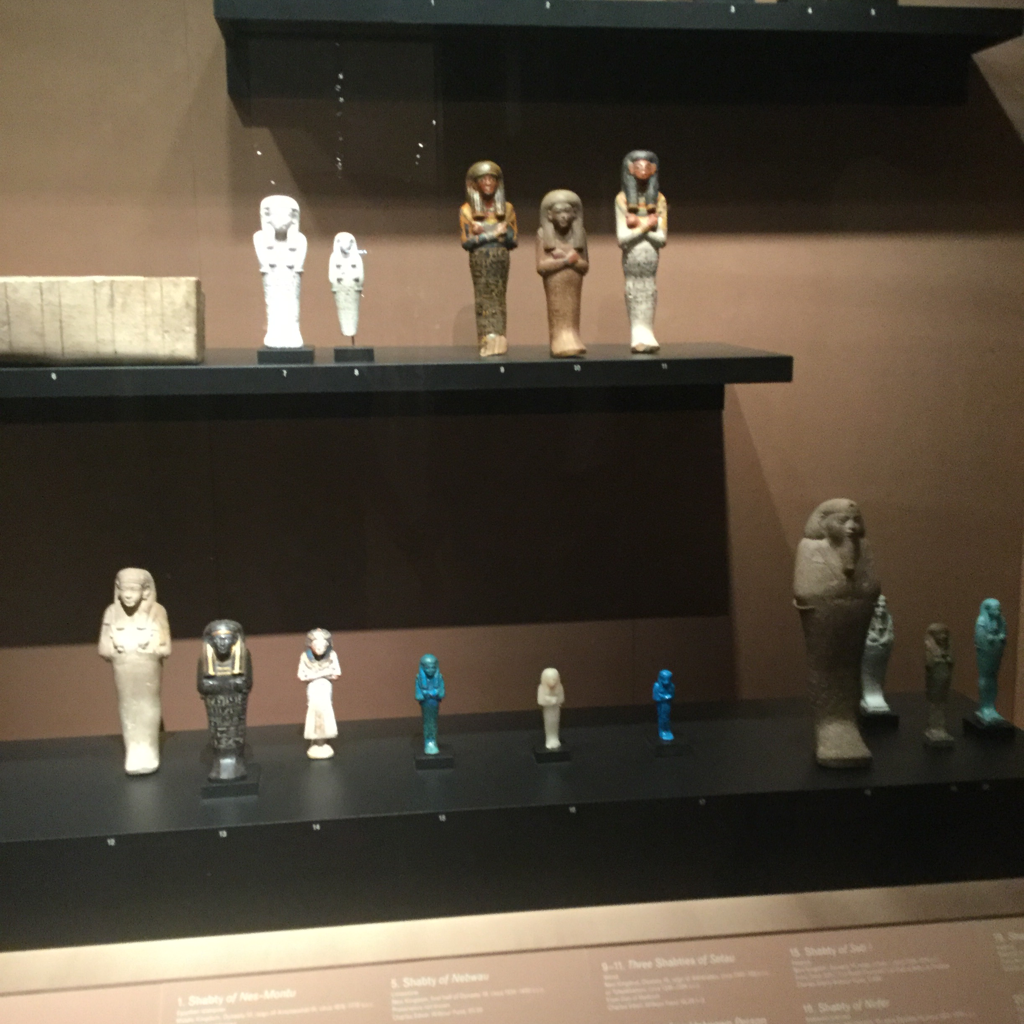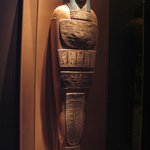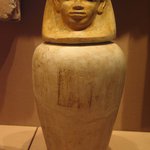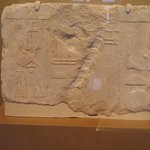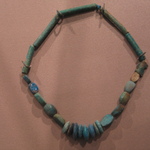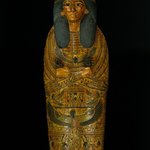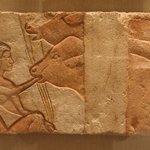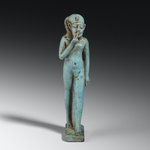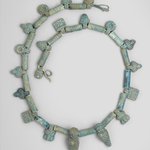

Shabty of Meshshentayet, 664–332 B.C.E. Faience, 7 13/16 x 2 x depth of base 1 9/16 in. (19.8 x 5.1 x 4 cm). Brooklyn Museum, Charles Edwin Wilbour Fund, 05.401. Creative Commons-BY (Photo: Brooklyn Museum, CUR.05.401_wwgA-3.jpg)

Shabty of Meshshentayet, 664–332 B.C.E. Faience, 7 13/16 x 2 x depth of base 1 9/16 in. (19.8 x 5.1 x 4 cm). Brooklyn Museum, Charles Edwin Wilbour Fund, 05.401. Creative Commons-BY (Photo: Brooklyn Museum, CUR.05.401.jpg)
Shabty of Meshshentayet
Egyptian, Classical, Ancient Near Eastern Art
On View: Funerary Gallery 2, Martha A. and Robert S. Rubin Gallery, 3rd Floor
The Egyptians manufactured funerary figurines, originally called shabties, as early as Dynasty 12 (1932–1759 B.C.E.). The earliest shabties are inscribed with either the deceased’s name (see nos. 1 and 2) or a simple form of Chapter 6 of the Book of the Dead. The rarity and high quality of the early shabties suggest that they were costly items produced for privileged persons.
Later, Chapter 6 began appearing more frequently on funerary figurines. The text mentions that they do agricultural tasks for the dead person: irrigating the fields, cultivating crops, and clearing away sand that blew in from the nearby desert.
As substitutes for the deceased, these figurines were sometimes given their own sarcophagi (see no. 6). To emphasize the agricultural function of the figurines, hoes and grain baskets were added to them (no. 8).
Wood (nos. 9–11), stone (nos. 12–14, 16), faience (no. 17), metal, and other materials were used beginning in Dynasty 18. By the end of the New Kingdom, statuettes for a single person were often mold-made by the hundreds and even thousands. Faience became the medium of choice, first in blue and later in light green or light blue (nos. 17, 20, 21).
Later, Chapter 6 began appearing more frequently on funerary figurines. The text mentions that they do agricultural tasks for the dead person: irrigating the fields, cultivating crops, and clearing away sand that blew in from the nearby desert.
As substitutes for the deceased, these figurines were sometimes given their own sarcophagi (see no. 6). To emphasize the agricultural function of the figurines, hoes and grain baskets were added to them (no. 8).
Wood (nos. 9–11), stone (nos. 12–14, 16), faience (no. 17), metal, and other materials were used beginning in Dynasty 18. By the end of the New Kingdom, statuettes for a single person were often mold-made by the hundreds and even thousands. Faience became the medium of choice, first in blue and later in light green or light blue (nos. 17, 20, 21).
MEDIUM
Faience
DATES
664–332 B.C.E.
DYNASTY
Dynasty 26 to Dynasty 31
PERIOD
Late Period
DIMENSIONS
7 13/16 x 2 x depth of base 1 9/16 in. (19.8 x 5.1 x 4 cm) (show scale)



COLLECTIONS
Egyptian, Classical, Ancient Near Eastern Art
ACCESSION NUMBER
05.401
CREDIT LINE
Charles Edwin Wilbour Fund
PROVENANCE
Archaeological provenance not yet documented; by April 1905, acquired by Claude Camille Rollin and Félix Bienaimé Feuardent of Paris, France; April 25, 1905, purchased from Claude Camille Rollin and Félix Bienaimé Feuardent by the Brooklyn Museum.
Provenance FAQ
EXHIBITIONS
MUSEUM LOCATION
This item is on view in Funerary Gallery 2, Martha A. and Robert S. Rubin Gallery, 3rd Floor
CAPTION
Shabty of Meshshentayet, 664–332 B.C.E. Faience, 7 13/16 x 2 x depth of base 1 9/16 in. (19.8 x 5.1 x 4 cm). Brooklyn Museum, Charles Edwin Wilbour Fund, 05.401. Creative Commons-BY (Photo: Brooklyn Museum, CUR.05.401_wwgA-3.jpg)
IMAGE
installation, West Wing gallery A-3 installation, CUR.05.401_wwgA-3.jpg. Brooklyn Museum photograph, 2005
"CUR" at the beginning of an image file name means that the image was created by a curatorial staff member. These study images may be digital point-and-shoot photographs, when we don\'t yet have high-quality studio photography, or they may be scans of older negatives, slides, or photographic prints, providing historical documentation of the object.
RIGHTS STATEMENT
Creative Commons-BY
You may download and use Brooklyn Museum images of this three-dimensional work in accordance with a Creative Commons license. Fair use, as understood under the United States Copyright Act, may also apply.
Please include caption information from this page and credit the Brooklyn Museum. If you need a high resolution file, please fill out our online application form (charges apply).
For further information about copyright, we recommend resources at the United States Library of Congress, Cornell University, Copyright and Cultural Institutions: Guidelines for U.S. Libraries, Archives, and Museums, and Copyright Watch.
For more information about the Museum's rights project, including how rights types are assigned, please see our blog posts on copyright.
If you have any information regarding this work and rights to it, please contact copyright@brooklynmuseum.org.
RECORD COMPLETENESS
Not every record you will find here is complete. More information is available for some works than for others, and some entries have been updated more recently. Records are frequently reviewed and revised, and we welcome any additional information you might have.




